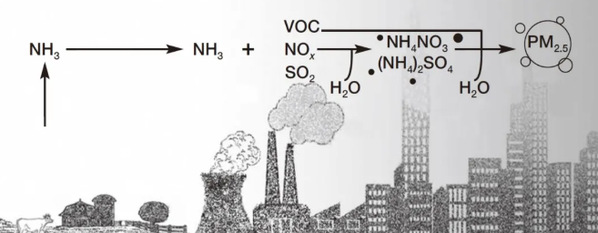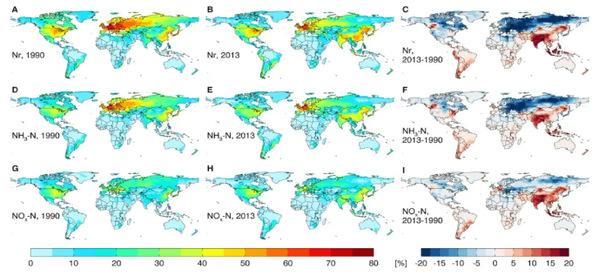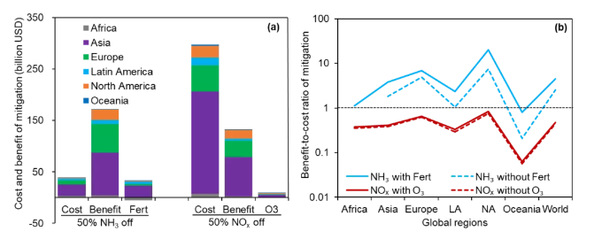Scientists discover more cost-effective way to mitigate PM2.5 air pollution
Nitrogen is intimately related to our life, and reactive nitrogen in the atmosphere is primarily comprised of ammonia (NH3) and nitrogen oxides (NOx), which are the main precursors of PM2.5. NOx stems principally from urban production activities while NH3 is emitted chiefly from agricultural production.
In a study published in Science on Nov. 5, researchers analyzed for the first time the contribution of ammonia (NH3) and nitrogen oxides (NOx) in the formation of air pollution from PM2.5 (fine particulate matter with a mass median aerodynamic diameter < 2.5 micrometers) and their health impact. They also investigated the pathways and costs of controlling nitrogen emissions to mitigate the adverse health effects of PM2.5 pollution.
The study, which has spanned more than four years, was finished by the team led by Prof. GU Baojing from the Zhejiang University College of Environmental and Resource Sciences in collaboration with the team led by Prof. ZHANG Lin from Peking University and the team led by Prof. Mark Sutton from the UK Centre for Ecology & Hydrology.

Prof. GU Baojing and his students
Nitrogen: A double-edged sword
Since industrial ammonia was synthesized in the 1920s, fertilizers have been manufactured accordingly and farmers have escaped from “dependence on the weather”. Nitrogen fertilizers have contributed immensely to agricultural output. Statistics indicate that their contribution adds up to about 50%.
It was previously thought that PM2.5 air pollution originated for the most part from cities. In fact, ammonia, which is primarily from rural areas, can also be transmitted to cities and react with such elements as NOx and sulfur to produce PM2.5, thus causing air pollution.

Nitrogen is indeed a double-edged sword. Data show that between 1990 and 2013, the total years of life lost (YLL) caused by PM2.5 pollution due to nitrogen emissions increased from 19.5 to 23.3 million globally. How can nitrogen emissions be effectively controlled within reasonable limits? The first step is to accurately assess the impact of nitrogen on air pollution.
However, the effect of nitrogen on PM2.5 pollution is not as “universal” as that of carbon on climate change. Comparatively speaking, the effect of nitrogen is marked by its substantial regional variation caused by climate conditions and population densities in different countries. So far, no universal assessment system has been developed. There is thus an urgent need to devise a common approach to comparing the health effects of nitrogen emissions in different countries and regions, thereby providing a scientific basis for controlling PM2.5 pollution by means of nitrogen management on a global scale.
Abating ammonia: A more cost-effective approach
GU Baojing et al. employed three atmospheric chemistry transport models—EMEP-WRF, TM5-FASST, and GEOS-Chem—to analyze the contribution of nitrogen compounds to total PM2.5 concentration, which is termed as the “N-share” of PM2.5 pollution, as well as their health effects. They also applied the GAINS model to estimate the implementation costs of nitrogen air pollution abatement.

N-shares of PM2.5 pollution and their changes between 1990 and 2013
Their research suggests that the effect of ammonia has been underestimated. “In the past, the effect of pollutants was often investigated from the mass-ratio perspective, allowing ammonia, which accounts for less than 10% of the total mass of PM2.5, to be largely ignored. We revisited this problem in terms of the molar share of chemical reactions. Using data models, we found that PM2.5 decreased by 40% or so when no nitrogen was emitted,” said Prof. Gu.
Researchers also constructed the N-share to quantify the contribution of global nitrogen emissions to PM2.5 health effects in different countries, and found that ammonia abatement was more cost-effective than NOx abatement in global PM2.5 pollution management.

Cost and benefit to reduce 50% of NH3 and NOx emission in 2013
As introduced by Prof. Gu, “Traditional studies are fragmented in their own disciplinary areas, which renders it formidable to see a whole picture strategically. Members on our team have different backgrounds and can integrate several aspects through cross-disciplinary studies so as to find a more appropriate analytical method.”
“To alleviate PM2.5 air pollution, it is of supreme importance to impose stricter controls on nitrogen oxides and ammonia emissions in the next phase of nitrogen control,” said Prof. Gu. “We need to guide air management from an urban-oriented strategy to an urban-rural synergic approach. Specifically, this can be achieved by implementing large-scale farming in order to promote optimal fertilization, which is estimated to reduce the use of chemical fertilizers by 1/3 and ammonia emissions by about 50%; on the other hand, relocating livestock farms based on the distribution of croplands to increase the manure recycle will finally lead to substantial reduction of ammonia emissions into the air.”